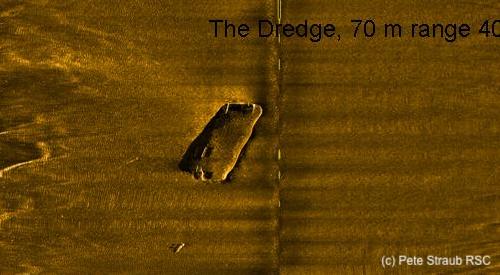United States Coast Guard 2 (7/7)
Preventive Safety
Safety at sea requires preventative and corrective measures. Too much is as bad as too little. A ship is similar to a delicately tuned instrument. If excessive cost and weight are devoted to safety, the ship will not be competitive and probably will never be built. Throughout the history of commercial vessel safety, there has been the constant struggle to provide a balance between the greatest degree of safety and reasonable cost.
The steam engine was married to the sailing ship in the early 19th century. Beginning in the second decade of that century, there was a series of shipboard boiler explosions, resulting in huge losses of life. Almost immediately two schools of thought concerning commercial vessel safety crystallized. There were those who favored strong federal regulations and those who opposed government interference into transportation. At first, the federal government followed a laissez-faire philosophy. Secretary of the Treasury Richard Rush remarked in 1825, "Legislative enactments are calculated to do mischief rather than prevent it...."
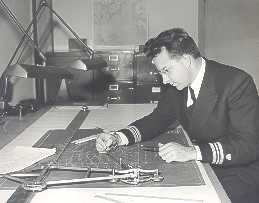
Right: a Coast Guard naval architect inspects the plans of a new merchant ship.
State governments attempted to establish safety standards for steam vessels; due to the interstate nature of waterborne commerce. The catalyst for federal action occurred in 1837 when the steamboat Pulaski exploded in North Carolina; 100 lives were lost. Congress passed an act "For the better security of the lives of passengers." This was the birth of commercial vessel inspection. The act provided the installation of fire-fighting and life-saving apparatus. Enforcement was the weak link; district judges appointed local persons to be inspectors. Obviously, in this small blossoming industry, the local individual competent to pass judgment must have had close ties with the ship owners. Also, no standards were set. Each inspector used his own judgment as to what was the maximum steam pressure permitted, and so on.
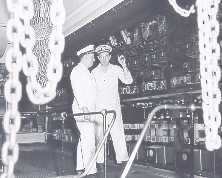
Right: a Coast Guard inspector inspects the generator control panel of a passenger vessel.
The evolution of technology outstripped these mild legislative controls even though updated, and disasters continued. From December 1851 through July of the following year, there were seven major disasters, costing nearly 700 lives. Congress responded with the Steamboat Inspection Act of 1852. This expanded the responsibilities of the Act of 1838 and corrected the major flaw of the earlier law by controlling inspections and licensing. This new law had its shortcomings as well. Only steamships carrying passengers were subject to its provisions. Thus, steam tugs, freighters, canal boats were exempt from the provisions of the 1852 law, although still remaining subject to those of the 1838 one.
The Civil War diverted America's efforts from commercial vessel safety, as it had from life-saving, and an awesome price was paid. Fifteen hundred people perished on board the stern-wheeler Sultana in 1865 in the largest U.S. commercial maritime disaster. Sultana embarked nearly all of the 376 allowed passengers. Taking advantage of the wartime environment, 2,000 Union veterans, most of whom were recently freed prisoners of war, were also packed on board. While plying the river between Memphis and Cairo, Ill., a boiler exploded and the ship went up like a torch.
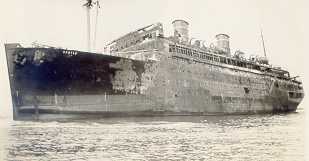
Future disasters brought in sharp focus areas needing improved safety regulations. Almost 1,000 lives were lost on General Slocum in 1904; as a result, safety regulations and inspection equipment were improved. More than 1,500 lives were lost on Titanic in 1912; certification and life-saving devices were improved. More than 100 lives were lost on board Morro Castle (right) in 1934 and another 45 on Mohawk the following year. Partly as a result of these two disasters, more marine legislation was passed in 1936 and 1937 than during the previous twenty years. To the novice, commercial vessel regulations seem a reaction to disaster. In fact, disaster has proven a catalyst for perfecting efforts previously undertaken.
Again demonstrating its utility in carrying out humanitarian missions, the Coast Guard ensures the safety of merchant traffic in the Atlantic from roaming icebergs. After the sinking of the Titanic in 1912, the Coast Guard was tasked with maintaining the International Ice Patrol, radioing reports of icebergs in the North Atlantic shipping lanes to merchant ships in the area. Today, this service is provided by Coast Guard aircraft

Right: a memorial service on board a cutter for the victims of the Titanic's sinking, a service conducted annually by the International Ice Patrol
The United States is an active member of the International Maritime Organization, an arm of the United Nations. IMO, composed of more than one hundred nations, has focused on such problems as safety at sea, prevention of pollution from ships, and technical cooperation among governments. These problems are under continual study and as solutions emerge, IMO sponsors conferences to draft international conventions and agreements. The Department of State looks to the Coast Guard as the agency having the expertise to enable effective U.S. participation.
Safety at sea depends upon competent mariners as well as safe ships. Since the early 1700s, harbor pilots had been licensed by colonial and later state governments. Illustrative of their widespread use, George Washington's presidential barge was manned by local pilots as he traveled throughout the country in the early 1790s. The first federal licensing of mariners was required by the Act of 1852, which authorized the Steamboat Inspection Service to issue licenses to engineers and pilots of steamers carrying passengers. Licensing has been refined and expanded throughout the decades to include masters and chief mates plus others in positions of responsibility on board all types of ships. Licensing and certifying of U.S. maritime personnel is another of the safety functions of the Coast Guard.
Today, one of the most visible missions of the Coast Guard is boating safety (below left). Yet, the beginnings of this responsibility are obscured by indecisive legislation. In 1896 the Secretary of the Treasury was authorized "to prescribe regulations to ensure the safety of passengers on ... [all] craft ... attendant ...upon regattas..." Although a very narrow law, it was the first attempt at regulating pleasure boat safety. In 1908 this modest responsibility was transferred from the Treasury to the Department of Commerce and Labor, which had only a single vessel to enforce the law!
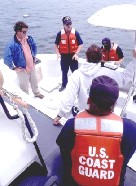
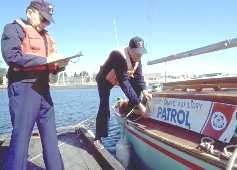
The Motorboat Act of 1910 finally established a creditable boating safety program. The act required boats to be equipped with navigation lights, whistles, fire extinguishers, and life preservers. Although enforcement was still a problem, the number of accidents immediately declined.
The next milestone occurred in 1939 when the volunteer organization, known today as the Coast Guard Auxiliary, was created. The Auxiliary (above right), working side by side with the regular Coast Guard, has significantly contributed to solving the enforcement problem. The 1940 Motorboat Act improved safety standards. Advances in technology have required constant updating in the law, with major changes occurring in 1958 and 1971. The Coast Guard's philosophy toward boating safety has been to educate the public rather than carry out punitive measures. The boating fatality rate during 1981 was 8.3 deaths for each 100,000 craft as compared to 21.4 deaths during 1965. There are fourteen million boats in American waters requiring constant vigil. The dedicated volunteers of the Coast Guard Auxiliary ably assist the service in ensuring that these craft operate safely.
adapted from USCG website

